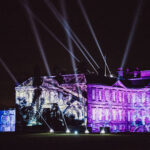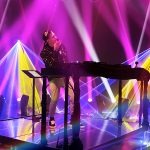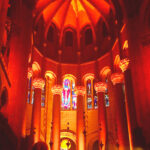The Republican and Democratic National Conventions, from the View of the Lighting Programmers
This summer saw the two major U.S. political parties hold their presidential national conventions in July — the Republican National Convention in Cleveland, OH at the Quicken Loans Arena, and the Democratic National Convention in Philadelphia, PA at the Wells Fargo Center. Both had large multi-level stages, venue-covering lighting rigs, enormous video wall elements and audiences full of enthusiastic delegates. Lighting a convention is no small assignment when you consider that the live images broadcast globally are indelible moments in history. The lighting designer for the 2016 RNC was David Grill, principal of David Grill Associates, Inc. Previously lighting director on five consecutive conventions, this was his first as the lead lighting designer. In Philadelphia, returning for his sixth DNC was lighting designer Robert Dickinson, Principal of Full Flood, Inc.
One thing not unique to political conventions is the tried-and-true production reality that to succeed, teamwork is essential. Grill’s lighting team at the RNC included assistant lighting designer Zachary Tomilo and lighting director/programmer Paul Sonnleitner. At the DNC, Dickinson’s lighting director was Travis Hagenbuch, the moving light programmer was Timothy F. Rogers, and the conventional lighting board operator was Ron Martin.

Both the RNC and DNC political conventions are massive undertaking. Many assume that they are just like a big arena concert. “I think a lot of people think that, but they really are not,” states Rogers, returning for his third DNC convention. “The difference is that this is much larger. The lighting rig is substantially bigger than a rock show, and the huge amount of video we have is not normally in an arena rock show. Power is always a big issue at the conventions because an incredible amount is needed. Again, people think, ‘Well, the arena does rock shows all the time.’ But when you realize how much the lighting and video needs for the huge stage setup and entire audience area; plus, they bring in additional air conditioning. Then you add in all of news organizations that have small studios spread throughout the arena’s suites with their lights, cameras, audio, monitors, etc. All of it needs lots of power. In fact, this year we had to bring in additional generators. It is not that it is a difficult show, [but] it is a huge show with a lot of things going on at once. Also, at rock shows, not every single light you hang and piece of gear you use needs to be sniffed by a security dog.”

Day in the Life
Obviously, running lights during a political convention requires organization, patience and, apparently, a very comfortable chair at your console, because you are not going to be leaving that chair for hours on end. The “show” itself lasts at least four hours nonstop, gavel to gavel, plus there are daily rehearsals, speaker walk-throughs and, should the speaker be accompanied by a Secret Service detail, in-place lockdowns, when you’re really not leaving your chair!
“We got there usually around 9 a.m., maybe 8 a.m., depending on what was going on,” says Sonnleitner, who was working his first national political convention. “I’d spend a couple hours doing notes. In the meantime, David would go to a meeting about that day’s run of show. About noon, we would start with staging, and if a speaker wanted to practice, they would have that opportunity. We would run through rehearsal from the top of the show to the end of the show in big blocks. No one actually spoke for the rehearsal, so we could move through in big sections. Then build the show, build cues, deciding what we were doing and what the set color was going to be in particular moments that day. The show started at 6:00 p.m. with audience warm-up, and then we went live between 7 and 8 p.m., depending on the day and who was speaking. Most days the show ended by 11 p.m. The night of Trump’s speech, it went until 11:45 or so.” For the morning and post-convention late-night news broadcasts, a general look using the arena’s Musco sports lights was created and left on.
In Philadelphia, Rogers and Martin followed a similar daily routine. “We had built our general looks for the convention during the load-in as things got put together,” explains Rogers. “Each day during the convention, I would program looks specific for that day’s events. We started at 9 a.m., handling notes and rehearsals. At 4 p.m., the convention gaveled in, and then during the evening, the big speeches and music acts would take the stage. We were usually walking out the door between 12:00 and 12:30 a.m.. We had crew come in between 5 and 6 a.m. who put up what I called the ‘news’ look. It was a look I created that turned on the stage and brought up some light in the arena. That gave a background to the networks that had studios setup overlooking the bowl of the arena for their morning shows.”
By their very nature, political conventions can be unpredictable, but long days with very few cues, especially if you are the board op handling the audience conventional lights and scenic lighting elements is predictable. Martin, a veteran of three conventions now, knew what to expect and takes it in stride. “This gig is all about knowing it’s going to be long,” he notes. “You have to persevere, because our day on the console goes from 10 a.m. to midnight. Most of the speeches are done in one cue. We’re not hitting strobes and changing colors in the middle of speeches. We did have a video down-look, meaning if they play a package through their speech, I pulled the conventional lights out and Tim went to a nice low blue look in the audience. If you compare it to a Broadway show, which has like 350 cues in 2.5 hours, here I’ve got like 10 changes in 7 hours.”

Consoles of Choice
At the RNC, Sonnleitner chose to control his rig with an MA Lighting grandMA2 console. He ran the show on a full-size, had a full-size FOH as a backup, and had a grandMA2 Light backstage in case everything went wrong. “The grandMA2 is my primary console of choice,” Sonnleitner says. “And for the RNC it was a logical choice.” Working on the live broadcast, Sonnleitner appreciated the range of inhibitive submasters and playback and speed masters on the grandMA2. “The console gave me a fully flexible surface on which to mix the television lighting levels,” he says. “With live television, being able to react quickly to the unanticipated is critical. For instance, I want to make sure I have a backlight palette that’s as high as everything will possibly go so I can run the backlight on an inhibitive as I’m probably going to be adjusting the levels down, because I don’t know what the color the next speaker’s hair is. I do the same thing with keylight and fill levels as well. GMA2 allows me to do a lot of that live.”
Sonnleitner also made good use of the live layout feature. “I used it to help me visualize and organize the rig,” he comments. “It’s important, because this isn’t a show where channel numbers necessarily mean something for purpose, they mean something as per location of the rig. It’s nice to have two different magic sheets — by ‘position’ and by ‘purpose,’ and allowing me to see both quickly. This lets me switch layouts and I can just touch a light and grab it quickly. Having that flexibility allows me to react quickly to what Dave sees and solve problems without having to flash through things.” Sonnleitner had 60 active control universes. He used the PRG Series 400 data distribution system with streaming ACN.
Rogers and Martin chose to go with ETC Eos Ti consoles for the DNC. There setup included two Eos 12K consoles as main and backup for the moving lights, and the conventional desks were two Eos 8K consoles for main and backup. The consoles were all connected to a PRG Series 400 data distribution system via Art-Net. “I decided to run the moving lights for this year’s DNC on the ETC Eos Ti console,” Rogers comments. “The console is well suited to a live show this big, and it worked great. The Eos is very powerful if you know how to use the desk. I had a fully-loaded fader wing for subs, which is imperative doing a TV show, in my opinion. Having multiple handles to put different inhibitive subs on and different looks is important.”
Martin similarly made use of inhibitive submasters to easily pull out whole sections of light when needed. “I would create a group and run it all from a sub,” Martin says. “The entire audience is one sub. The audience, in this particular case, is broken down into upper bowl, middle bowl, lower bowl and floor. I created inhibits so I can override and take out a section if I don’t need it. At the start of sessions, if the upper bowls were empty, I would inhibit the lights for the entire upper bowl. The intensities for the audience PARs were just under one giant handle on a sub, but I could take any of those and pull them down with an inhibit. I don’t ever want to be locked in a cue.”
With such a large rig, and needing to have quick response when moving around the venue for things like state roll calls, the ETC Eos Magic Sheets feature was ideal for both Rogers and Martin. “I used Magic Sheets a lot,” says Rogers. “Ron and I imported blueprints of the actual arena to use as the background to our Magic Sheets so that we could reference the arena accurately. Then I could go through and label the different sections and know that one of these two lights were lighting this section. When we were on camera and we needed to pull something down in section 213, I could look over at my Magic Sheet and know that fixtures 178 and 179 are lighting that section. That, I think, was one of the most valuable tools.”

Everywhere a Camera
Martin agrees, saying that “having a visual interface that lets me lock where a light is and then code it to what it does later, is key for us. Here on the DNC, no one’s ever going to say ‘I need channel 67.’ They say ‘the cross light on the audience from left is too hot.’ Running the entire show from a picture of the plot makes that so much simpler. Especially with so many cameras that we don’t control. Being a theatre person, when someone says ‘what’s that light?’ I want to turn towards the actual stage, but you need to look at the monitor and the camera has no reference. The shot could be coming from anywhere. So literally having pictures on Magic Sheets of what things are with a channel button in the middle makes it super easy.”
Accepting that you are lighting for cameras and angles you may or may not even know about was also something Sonnleitner addressed. “What’s interesting about doing a convention is that it’s a pool video feed,” describes Sonnleitner. “You have to realize that you’re not looking at every particular camera in the venue. The networks, like CBS, might use 10 of our cameras and our line cut and maybe 10 of their own cameras. Everything you light is basically keyed from four directions. You want to make sure the light level is the same across the floor in its entirety, because even though your cameras might be in only two or three areas, somebody has a camera in every area. Our job was to maintain the light levels and make sure everyone had the right exposure and the right color temperature information of what we were doing. We sent an email to all the networks with the information, including the color temp. In this case, we went with 4,400K. Then I look out around the arena and see that most everyone has their panels set to 4,400K, but there were one or two going their own way with 6,500K. I just laughed, thinking ‘Someone didn’t read their email.’”

Keys and Bowl Light
For Grill’s design for the RNC, he had a keylighting system that “consisted of [Philips] Vari-Lite 3515s, along with PRG Best Boy Spots, which were a big part of our keylight system,” Sonnleitner says. “We used a lot of the PRG Best Boy Washes as a primary fixture for the rest of the venue.” Grill also used the Clay Paky Mythos as effects lighting. In total, the rig had nearly 400 automated lights. He also used Lycian 3kW followspots. In place of a conventional lighting system, Grill took advantage of the arena’s system of Musco sports lights with DMX-controllable shutters. Seth Weldon was the Conventional light Board Operator and so instead controlled the Musco’s shutters during the convention.
Dickinson’s plot had over 250 automated units. The Philips Vari-Lite VL3500 Spot and Wash units along with PRG Best Boy Spots were the predominant top layer of keylight and to section up the audience on the floor and bowl. The rig also included Solaris Flare strobes, Philips Color Kinetics Color Blaze LED striplights and a number of the Martin Professional VDO Sceptron tubes for truss toners. The Sceptrons are a replacement for VersaTUBEs. The conventional package consisted of 120 ETC Source Four ellipsoidals along with ETC Source Four PARs and aluminum PARs; all of which provided a warm base for all of the audience areas from the floor up through the upper balconies. There were four PRG GroundControl followspots with Best Boy Spot HP luminaires and a range of Lycian and Strong followspots. PRG supplied the lighting packages for both conventions.

Then the Balloons Drop
While running the consoles at the convention means long and at times tedious hours, it’s a unique project and hey, you do get four years to recuperate. As Martin concludes, “It’s a great gig because it is a moment in time, in history. I got to be there when we nominated the first female Presidential candidate. And to be doing what you do for a living while you’re there, working with a group of people who are really good at what they do; all of us part of making a moment in history that you see on the monitor being televised on 14 networks at the same moment, that’s a big deal.”


